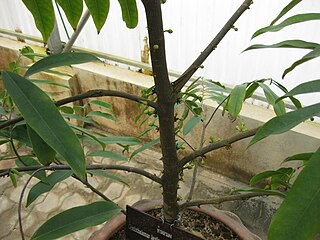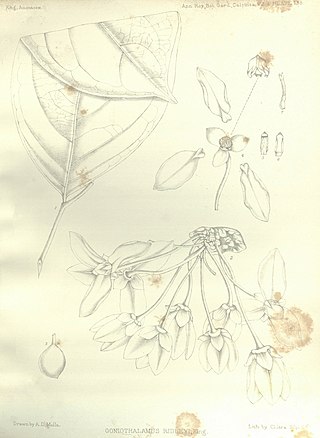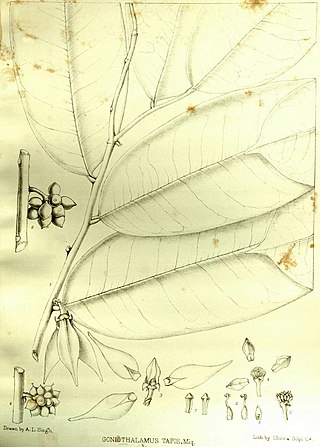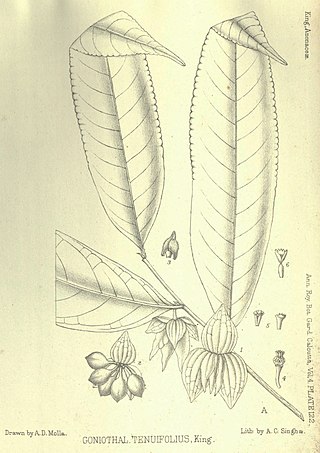Goniothalamus cheliensis is a species of plant in the Annonaceae family. It is native to China and Thailand. Bioactive molecules isolated from its roots have been reported to have cytotoxic activity in tests with cultured human cancer cells.

Goniothalamus calvicarpus is a species of plant in the family Annonaceae. It is native to China, Laos and Thailand. William Grant Craib, the British botanist who first formally described the species, named it after its hairless fruit.
Goniothalamus chartaceus is a species of plant in the family Annonaceae. It is native to Vietnam. Hui-lin Li, the Chinese botanist who first formally described the species, named it after its papery leaves.
Goniothalamus elegans is a species of plant in the family Annonaceae. It is native to Thailand and Vietnam. Suzanne Jovet-Ast, the French botanist who first formally described the species, named it after its elegant thin, flexible leaves.

Goniothalamus giganteus is a species of plant in the family Annonaceae. It is native to Malaya, Myanmar, Sumatra and Thailand. Joseph Dalton Hooker and Thomas Thomson, the British botanists who first formally described the species, named it after its exceptionally large flowers.

Goniothalamus laoticus is a species of plant in the family Annonaceae. It is native to Laos and Thailand. It was originally described by the French botanists Achille Eugène Finet and François Gagnepain using the basionym Mitrephora laotica. In Thailand it is commonly called Khao Lam-dong and is used as a traditional medicine.
Goniothalamus latestigma is a species of plant in the family Annonaceae. It is native to Myanmar and Thailand. Cecil Ernest Claude Fischer, the botanist who first formally described the species, named it after its broad stigmas.

Goniothalamus macrophyllus is a species of plant in the family Annonaceae. It is native to Borneo, Java, the Malay Peninsula, Sumatra and Thailand. Carl Ludwig Blume, the German-Dutch botanist who first formally described the species using the basionym Unona macrophylla, named it after its large leaves. It is commonly called Penawar Hitam in the Malaya Peninsula, Ki Cantung in Indonesia, Limpanas Putih in Brunei, and Chin Dok Diao in Thailand.

Goniothalamus malayanus is a species of plant in the family Annonaceae. It is native to Borneo, the Malay Peninsula, the Nicobar Islands, Sumatra and Thailand. Joseph Dalton Hooker and Thomas Thomson, the British botanists who first formally described the species, named it after part of its habitat range, British Malaya.

Goniothalamus ridleyi is a species of plant in the family Annonaceae. It is native to Borneo, Peninsular Malaysia, Sumatra and Thailand. George King, who first formally described the species, named it after the English botanist Henry Nicholas Ridley who collected the specimen King examined.
Goniothalamus rotundisepalus is a species of plant in the family Annonaceae. It is native to Peninsular Malaysia and Thailand. Murray Ross Henderson, the Scottish botanist who first formally described the species, named it after its sepals which are rounded like the arc of a circle.
Goniothalamus sawtehii is a species of plant in the family Annonaceae. It is native to Myanmar and Thailand. Cecil Ernest Claude Fischer the botanists who first formally described the species, named it in honor of Maung Saw Teh, a plant collector who provided the specimen examined by Fischer.

Goniothalamus scortechinii is a species of plant in the family Annonaceae. It is native to Peninsular Malaysia and Thailand. George King, the British botanist who first formally described the species, named it in honor of Benedetto Scortechini, an Italian priest and member of the Linnean Society of London and New South Wales who collected many important botanical samples in Peninsular Malaysia.

Goniothalamus tapis is a species of plant in the family Annonaceae. It is native to Peninsular Malaysia, Sumatra, and Thailand. Friedrich Anton Wilhelm Miquel, the Dutch botanists who first formally described the species, named it after a local vernacular name, Kajoe-tapis, from Pariaman Sumatra where the specimen he examined was found.

Goniothalamus tenuifolius is a species of plant in the family Annonaceae. It is native to Peninsular Malaysia, Thailand and Vietnam. George King, the British botanist who first formally described the species, named it after its slender leaved foliage.
Goniothalamus tortilipetalus is a species of plant in the family Annonaceae. It is native to Peninsular Malaysia and Thailand. Murray Ross Henderson, the Scottish botanist who first formally described the species, named it after its twisted petals.

Goniothalamus uvarioides is a species of plant in the family Annonaceae. It is native to Peninsular Malaysia and Thailand. George King, the British botanist who first formally described the species, named it after its fruit which he thought resembled those of the genus Uvaria more than those of Goniothalamus.
Goniothalamus velutinus is a species of plant in the family Annonaceae. It is native to Borneo. Herbert Airy Shaw, the English botanist who first formally described the species, named it after the dense velvety hair on its branchlets and petioles.

Mitrephora heyneana is a species of plant in the family Annonaceae. It is native to India and Sri Lanka. Joseph Dalton Hooker and Thomas Thomson, the British botanists who first formally described the species under the basionym Orophea heyneana, named it after Benjamin Heyne a German botanist who collected and described many plant species from India.
Goniothalamus undulatus is a species of plant in the family Annonaceae. It is native to Thailand and Vietnam. Henry Nicholas Ridley, the English botanist who first formally described the species, named it after the wavy edges of its leaves.











